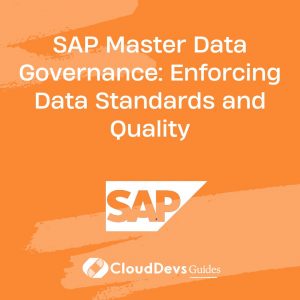SAP Master Data Governance: Enforcing Data Standards and Quality
Effective data management is essential for maintaining accurate and reliable business operations. SAP Master Data Governance (MDG) provides a comprehensive framework for managing and enforcing data standards, ensuring high-quality data across your organization. This blog explores how SAP MDG can be utilized to enforce data standards and improve data quality.
Understanding SAP Master Data Governance
SAP Master Data Governance is a suite of tools and functionalities designed to manage and oversee master data throughout its lifecycle. It helps organizations maintain data accuracy, consistency, and compliance with predefined standards. Key components of SAP MDG include data modeling, data quality management, and workflow management.
Using SAP MDG for Data Standardization
SAP MDG facilitates the enforcement of data standards through various mechanisms, including data modeling, validation rules, and governance workflows. Below are key aspects of how SAP MDG helps in maintaining data standards:
1. Data Modeling
SAP MDG enables organizations to define and implement data models that standardize master data structures across different systems. This ensures consistency and accuracy in data representation.
Example: Creating a Data Model
In SAP MDG, you can define data models using the SAP MDG Data Modeler, which allows you to create and customize master data entities, attributes, and relationships. This model serves as a blueprint for data consistency.
– Define master data entities (e.g., Customer, Supplier).
– Specify attributes (e.g., Name, Address).
– Establish relationships (e.g., Customer to Order).
2. Data Validation Rules
SAP MDG supports the creation of validation rules to ensure data quality and compliance with predefined standards. Validation rules can be used to check data integrity, completeness, and accuracy.
Example: Implementing Validation Rules
Use SAP MDG’s validation framework to create rules that enforce data standards. For instance, you can create rules to ensure that a customer record contains a valid email address and a unique customer ID.
– Define validation rules for required fields.
– Implement rules for format and uniqueness checks.
– Configure error messages for rule violations.
3. Governance Workflows
SAP MDG provides workflow capabilities to manage data governance processes. These workflows facilitate data approval, review, and change management, ensuring that data changes adhere to organizational standards.
Example: Setting Up a Governance Workflow
Configure workflows in SAP MDG to automate data approval processes. For example, you can set up a workflow to require managerial approval for changes to critical master data records.
– Define workflow stages (e.g., Draft, Review, Approval).
– Assign roles and responsibilities (e.g., Data Stewards, Approvers).
– Automate notifications and approvals.
4. Data Quality Management
SAP MDG includes tools for monitoring and improving data quality. These tools help identify and address data issues, such as duplicates, inaccuracies, and inconsistencies.
Example: Monitoring Data Quality
Utilize SAP MDG’s data quality dashboard to track data quality metrics and identify areas for improvement. The dashboard provides insights into data quality issues and trends.
– Monitor data quality metrics (e.g., completeness, accuracy).
– Generate reports on data quality issues.
– Implement data cleansing activities.
5. Integrating with Other SAP Modules
SAP MDG integrates seamlessly with other SAP modules, such as SAP S/4HANA and SAP Business Suite, to ensure that master data is consistent and synchronized across different systems.
Example: Integration with SAP S/4HANA
Configure SAP MDG to synchronize master data with SAP S/4HANA, ensuring that data changes in MDG are reflected in other SAP modules and vice versa.
– Set up data integration settings.
– Define data synchronization rules.
– Monitor integration processes.
Conclusion
SAP Master Data Governance provides a robust framework for enforcing data standards and ensuring high-quality data management across your organization. By leveraging data modeling, validation rules, governance workflows, and data quality management tools, SAP MDG helps organizations maintain accurate and reliable master data.
Further Reading:
Table of Contents








